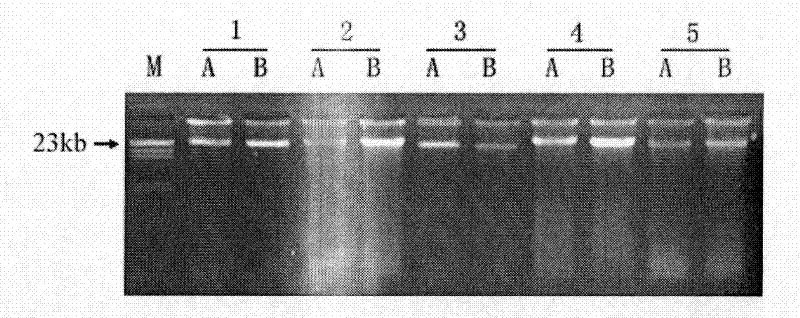Simple, efficient and cheap method for purifying forest soil sample DNA
A soil sample and forest soil technology, applied in the field of total DNA purification of forest soil samples, can solve the problems of high cost, complex and time-consuming, etc., and achieve the effect of low cost, wide application range and simple operation
- Summary
- Abstract
- Description
- Claims
- Application Information
AI Technical Summary
Problems solved by technology
Method used
Image
Examples
Embodiment 1
[0023] Example 1: Sample Sampling
[0024] The five soil samples used in this study were all taken from the 0-10cm surface soil of Lin’an Bamboo Forest in Hangzhou, China, including three samples with high impurity content (sample 2, 4, 5) and two samples with low impurity content (sample 1, 3), all samples were taken in triplicate.
Embodiment 2
[0025] Embodiment 2: Extraction of initial DNA crude product
[0026] Step (1): The crude DNA was extracted using a slightly modified CTAB-SDS method (Zhou et al., 1996. Applied and Environmental Microbiology, 62: 316-322): 5 g of soil sample and 13.5 mL of DNA extraction buffer (100 mM Tris- HCl, 100 mM sodium EDTA [pH 8.0], 100 mM sodium phosphate [pH 8.0], 1.5M NaCl, 1% CTAB) and 100 μL proteinase K (10 mg / mL) were mixed in a centrifuge tube, and then heated at 37 °C at 225 rpm Speed horizontal oscillation for 30 minutes. After shaking, add 1.5mL of 20% SDS, and then place it in a constant temperature water bath at 65°C for 2 hours. During this period, gently invert the centrifuge tube every 15 to 20 minutes, and then centrifuge the sample at 6000 rpm for 10 minutes at room temperature. minute. Take the supernatant and transfer it to another new centrifuge tube, add an equal volume of chloroform-amylisoalcohol (24:1 (v / v)) to the supernatant to mix and extract, and cent...
Embodiment 3
[0027] Embodiment 3: further purification of crude product DNA
[0028] Step (2): Use 2 mL of extraction buffer to dissolve the crude nucleic acid precipitate, use a pipette to accelerate the dissolution several times, then place it in a water bath at 65°C for 10 minutes, add an equal volume of chloroform-amylisoalcohol solution (chloroform:amyl isoalcohol) isoalcohol=24:1), centrifuged at 16000 rpm for 5 minutes. Take the supernatant, add 0.6 times the volume of isopropanol, let stand at room temperature for a few minutes, then centrifuge at 16,000 rpm for 10 minutes at room temperature, discard the supernatant, and wash the precipitate with pre-cooled 70% alcohol or ethanol , and the DNA obtained after drying was dissolved in 100 μL TE buffer.
[0029] Step (3): The DNA recovered in step (2) is further purified with a silica gel column. Add 3 times the volume of QIAquick Gel Extraction Kit buffer to 100 μL of crude DNA. After a few minutes, transfer to the recovery column ...
PUM
 Login to View More
Login to View More Abstract
Description
Claims
Application Information
 Login to View More
Login to View More - R&D Engineer
- R&D Manager
- IP Professional
- Industry Leading Data Capabilities
- Powerful AI technology
- Patent DNA Extraction
Browse by: Latest US Patents, China's latest patents, Technical Efficacy Thesaurus, Application Domain, Technology Topic, Popular Technical Reports.
© 2024 PatSnap. All rights reserved.Legal|Privacy policy|Modern Slavery Act Transparency Statement|Sitemap|About US| Contact US: help@patsnap.com










